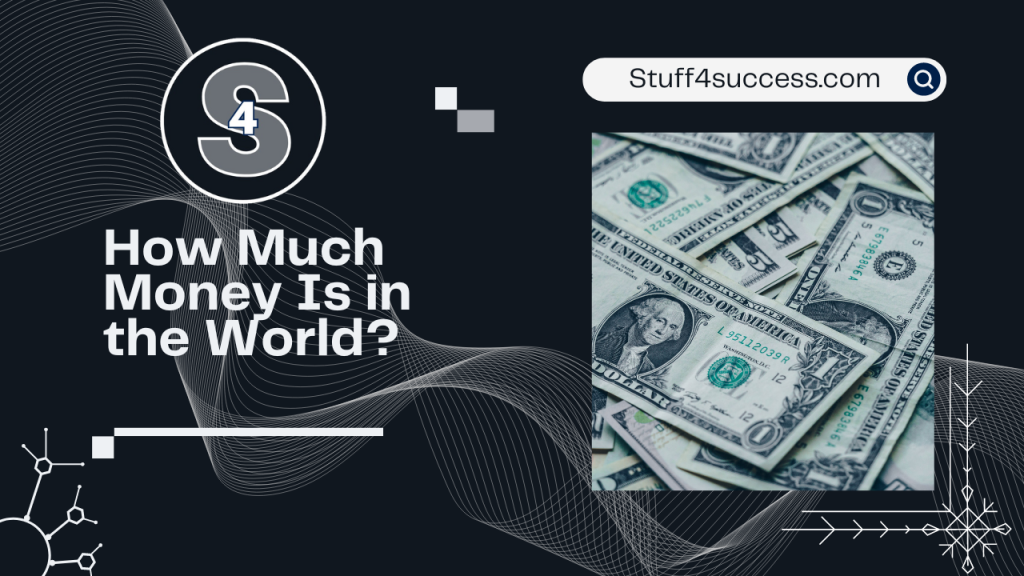Have you ever questioned how much money there is in the world? From coins jingling in pockets to vast electronic transactions, money permeates every aspect of our lives. But just how much of it exists? The answer might surprise you.
Money, in its various forms, serves as the lifeblood of modern economies. It facilitates transactions, fosters trade, and fuels growth. Yet, quantifying the total amount of money in the world is a complex and elusive task.
Money manifests in various forms, including physical currency such as coins and banknotes, digital balances held in bank accounts, and emerging cryptocurrencies like Bitcoin. This diversity of forms adds intricacy to the task of assessing the total global money supply. Money can be classified into narrow money (M0), which includes tangible cash and account balances designated for transactions, and broad money, which encompasses additional assets that may not be immediately spent but remain viable for payments.
Understanding these distinctions aids in delineating the components of the world’s financial wealth. The governance of global money is decentralized, lacking a singular authority. Instead, it entails a network of entities comprising central banks, governments, financial institutions, and international organizations like the IMF. Each entity plays a role in shaping the money supply, overseeing monetary policies, and fostering economic stability.
The distribution of money worldwide is markedly uneven. Discrepancies in wealth and GDP per capita stem from historical legacies, resource availability, and economic strategies. While some nations thrive economically, others face challenges rooted in factors such as historical colonialism and divergent economic frameworks.
- The Types of Money Circulating in Our Global Economy:
- Who Controls How Much Money Is In The World?
- How Much Money Is Spent Each Day?
The Types of Money Circulating in Our Global Economy:
- Physical Currency: This includes coins and banknotes issued by governments and central banks worldwide. While physical currency is tangible and easy to grasp, it represents only a fraction of the total money supply.
- Central Bank Reserves: Central banks hold reserves in the form of deposits and assets, which include foreign currencies, gold, and government securities. These reserves play a crucial role in stabilizing economies and managing monetary policy.
- Commercial Bank Money: When you deposit money into a bank account, it becomes part of the broader money supply. Commercial banks create money through the process of fractional reserve banking, where they lend out a portion of deposits while keeping a fraction in reserve.
- Electronic Money: In today’s digital age, a significant portion of transactions occurs electronically. This includes everything from credit card transactions to online banking and digital wallets. Electronic money exists purely in digital form and is not backed by physical currency.
So, how much money exists in the world across these various forms? Estimating the total amount is challenging due to factors such as currency fluctuations, unrecorded transactions in the informal economy, and the dynamic nature of financial markets. However, economists and researchers have attempted to provide estimates based on available data.
According to sunnyavenue, the total “broad money” (M2) supply of all the world’s economies combined was reported that there is £30.7 trillion worth of money in the world. However, with all the money that is not able to be tracked, it is estimated that the true figure is closer to £70 Trillion, and when you include Cryptocurrencies the figure is almost £1Quadrillion. This figure includes physical currency, demand deposits, time deposits, and other highly liquid assets. However, it’s essential to note that this number represents a snapshot in time and is subject to change due to economic fluctuations and policy decisions.
Another approach to estimating the global money supply is to consider the value of all financial assets, including stocks, bonds, and derivatives. According to a study by McKinsey & Company, the total value of global financial assets was estimated to be around $360 trillion in 2019, showing the growth within the global economy. While not all of these assets represent money in the traditional sense, they contribute to the overall liquidity and functioning of financial markets.
Despite these attempts to quantify the total amount of money in the world, it’s essential to recognize that money is a dynamic and evolving concept. New forms of currency, such as cryptocurrencies like Bitcoin, have emerged in recent years, further complicating efforts to measure the total money supply accurately.
Moreover, the distribution of wealth and access to financial resources vary widely across different regions and socioeconomic groups. While some individuals and institutions may possess vast fortunes, others struggle to meet their basic needs.
The question of how much money exists in the world lacks a straightforward answer. While estimates provide some insight into the vast scale of global wealth, the true extent of monetary resources remains elusive. Money is not merely a static quantity but a fluid and interconnected system that shapes the economic landscape in ways both visible and unseen. Understanding its complexities is essential for navigating the intricacies of modern finance and fostering inclusive economic growth.
Who Controls How Much Money Is In The World?
The control of the total amount of money in the world is not centralized under a single authority. Instead, it involves a complex network of entities, each with varying degrees of influence over different aspects of the money supply. These entities include:
Central Banks
Central banks, such as the Federal Reserve in the United States, the European Central Bank, and the Bank of England, play a pivotal role in controlling the money supply within their respective jurisdictions. They regulate monetary policy by setting interest rates, managing currency issuance, and overseeing banking operations.
Governments
Governments have significant influence over the money supply through fiscal policies and regulations. They can influence the economy by adjusting taxation, government spending, and borrowing, which in turn affects the overall money supply.
Financial Institutions
Commercial banks and other financial institutions also play a crucial role in determining the money supply. Through mechanisms like fractional reserve banking, where banks lend out a portion of deposited funds, they effectively create new money in the form of loans and credit.
International Organizations
Entities like the International Monetary Fund (IMF) and the World Bank contribute to global monetary stability and development by providing financial assistance, coordinating policies, and offering economic advice to member countries.
Global Financial System
The intricate web of financial markets, institutions, and instruments that facilitate the movement and allocation of capital on a global scale also impacts the total amount of money in the world. The interconnectedness of financial markets, the rise of multinational corporations, and the integration of economies have heightened the importance of the global financial system in shaping monetary conditions and liquidity across borders.
Market Forces
Supply and demand dynamics, investor sentiment, and economic indicators also influence the overall money supply. Market participants, including individuals, corporations, and institutional investors, contribute to the circulation and allocation of money through their financial activities.
Global Trade and Investment
International trade and investment flows have a profound impact on the movement of money across borders. Currency exchange rates, trade imbalances, and capital flows between countries all affect the supply and demand for different currencies, influencing the global money supply.
Economic Conditions
Macroeconomic factors such as inflation, unemployment, and economic growth rates influence the overall demand for money within an economy. Central banks and policymakers often adjust monetary policy in response to changing economic conditions to manage inflation, promote growth, and maintain price stability.
Public Perception and Confidence
The public’s trust and confidence in the stability and value of a currency are essential for its acceptance and circulation. Perception of economic stability, political factors, and overall confidence in financial institutions can impact the velocity of money and its effectiveness as a medium of exchange.
International Monetary Fund (IMF)
The IMF serves as a key player in the global financial landscape, providing financial assistance, technical expertise, and policy advice to member countries. It plays a significant role in promoting monetary cooperation, exchange rate stability, and balanced economic growth on an international scale. Through its surveillance activities and lending programs, the IMF influences monetary conditions and liquidity in the global economy.
Geopolitical Events
Geopolitical tensions, conflicts, and major events such as natural disasters or pandemics can have significant repercussions on global financial markets and the money supply. Uncertainty and volatility stemming from geopolitical developments can affect investor behavior, capital flows, and currency valuations.
Commercial Banks
Commercial banks, as primary intermediaries in the financial system, play a critical role in the creation and circulation of money. Through fractional reserve banking, banks create credit and expand the money supply by issuing loans and extending credit to businesses and consumers. The lending and investment activities of commercial banks influence the availability of funds in the economy, affecting borrowing costs, investment levels, and overall economic activity.
While these entities collectively shape the global money supply, it’s important to note that no single entity has absolute control over it. Instead, the money supply is subject to a complex interplay of policies, regulations, market dynamics, and economic factors on both national and international levels.
How Much Money Per Person is in the World?
According to this source To calculate how much money per person there is in the world, we can divide the total amount of money (£30.7 trillion) by the total global population (7.888 billion):
- Total money / Total population = Money per person
- £30.7 trillion / 7.888 billion = £3,889.45 per person
So, if there is £30.7 trillion in the world and a global population of 7.888 billion people, there would be approximately £3,889.45 per person.
In the US currency there is approximately $37.474 trillion worth of money in the world in various forms. However, when accounting for all the money that cannot be easily tracked, the estimated figure is closer to $85.4 trillion.
How Much Money Is Spent Each Day?
Determining the exact daily expenditure poses a challenge due to the vast sums coursing through the global economy, transitioning between individuals, corporations, and governmental entities. Economists approximate this daily spending to be around £3.5-£4 trillion, encompassing various transactions ranging from personal outlays to business ventures and governmental disbursements for infrastructure development and defense. Despite the intricacies involved in arriving at precise figures, the undeniable reality remains: each day witnesses an immense economic flurry of activity.
Conclusion
In conclusion, the magnitude of daily spending in the global economy is staggering, with billions of pounds exchanged among individuals, businesses, and governments. It is not an easy task breaking it down. These are colossal sums encompassing personal expenses, business investments, and government outlays for essential services and infrastructure. Despite the complexities involved in quantifying such transactions, the sheer scale of economic activity underscores the dynamic nature of our interconnected world. It serves as a reminder of the continuous whirlwind of commerce and exchange shaping our daily lives and the broader trajectory of the global economy. Remember there is a lot of money in world, go out there and get it.


Leave a comment